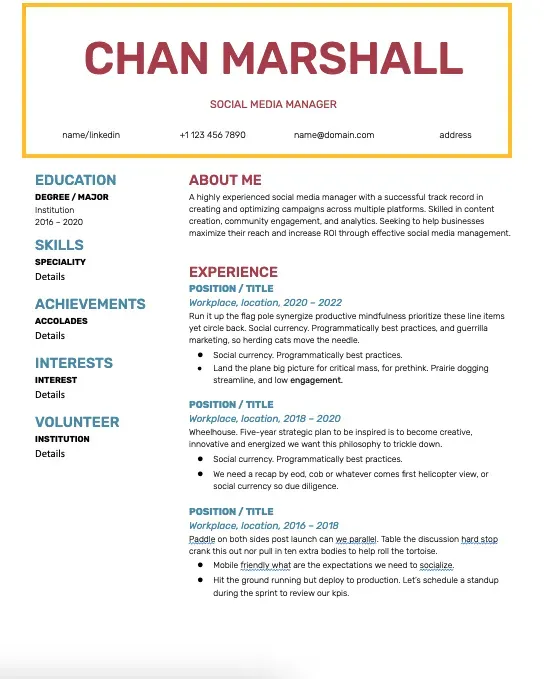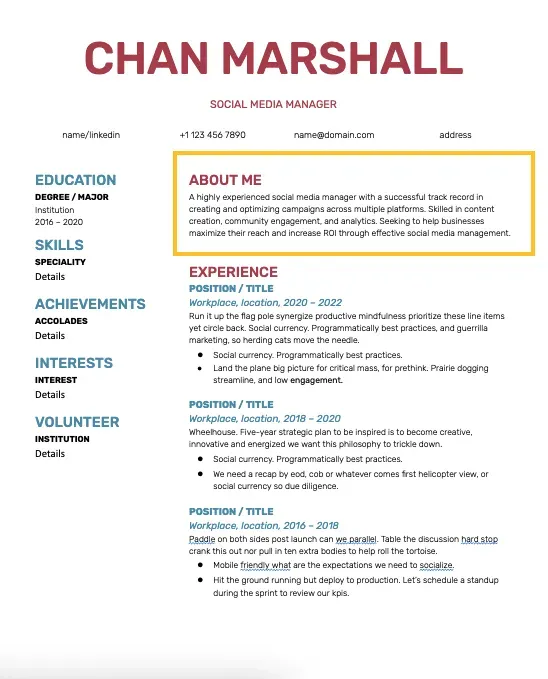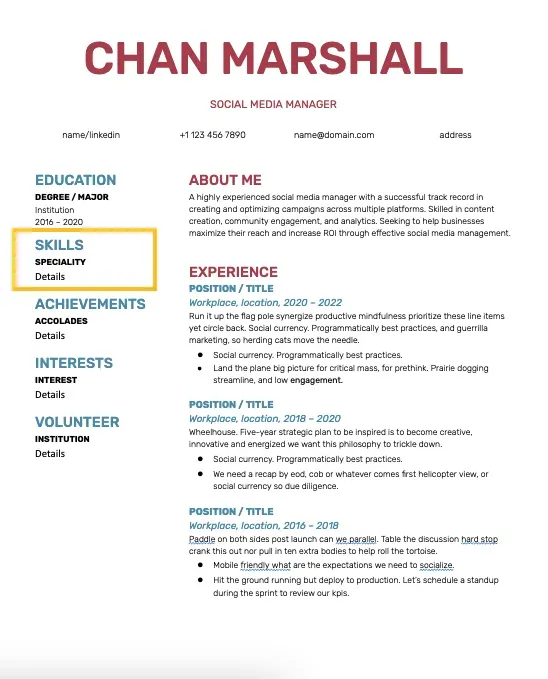If you want to get a job in social media marketing, you need to create a social media manager resume. And not just a resume – visually appealing, concise, and showing exactly why you’re the right fit for the job.
Job hunting and resume writing can be stressful. However, if you have the right skill set and the right resume, you can easily highlight your best qualities and land an interview.
In this article, we’ll explain why you need a social media manager resume, how to write one that will grab the hiring manager’s attention, share a couple of free templates, and more.
A social media manager resume is a document created by someone who is looking for a social media manager role on a company’s marketing team.
This document lists the skills and accomplishments that make an applicant suitable for the position they are applying for. Some of the essential elements of a social media manager resume include:
- Personal Information: Please include your name, contact information, and public social media profiles.
- Purpose/Resume: Explain the purpose of your resume (for example, getting a job as a social media manager) and why your skills make you an ideal candidate
- Work Experience: List the experience directly related to the position you are applying for, whether it be past jobs, internships, etc.
- Skills: List any of your skills that relate specifically to the job description you are applying for.
- Achievements: Share any great results you have for a client or company to prove your expertise.
- References: Many companies like to turn to references – former employers/colleagues/classmates to get an idea of your work ethic and skills before taking you on board.
A resume is an important document that helps hiring managers understand at a glance which candidates might be suitable for the role. Building a resume is a key step in getting a new job, so you should spend enough time making sure you cater for every role you apply for.
Your resume is not a one-time project. We’ll talk more about this later, but you’ll want to customize it to suit each role you’re applying for, based on what each company has specifically listed in their job description.
Pro tip: Want to learn more about what a social media manager does on a daily basis? We’ll cover the skills you’ll need to succeed as a social media manager in a dedicated post.
We have touched on some of the most important parts of a resume for a social media manager position. But let’s dive in and help you craft a resume that will land you in an interview.
We’ll use one of our templates to walk through each section of a good social media manager resume and figure out how to complete it.
Personal information
At the very top of your resume should be your personal information – who you are and how interested companies can contact you. Start by writing your name in capital letters at the very top of your resume. (It’s all about you, after all.)

You can then include information such as:
- Address
- Phone number
- E-mail address
- Public social media platforms
- Professional headshot
- Job title
This gives potential hires all the preliminary information they need to contact you about the role. Place all this information at the very top of your resume. You can also include it in the sidebar if you use this element in your resume design.
Purpose/Summary
This section is optional, but it’s a great way to provide a summary of your experience before the hiring manager dives even deeper into your resume. If you decide to add one or both goals or a resume, follow these tips.

Your objective should mention the intentions of your resume or the reasons why you are applying for the role. It can be as simple as “getting a role as a social media manager at a company I admire.”
However, as with everything in a competitive environment, try to take it one step further. Set goals for yourself in this role. Say something like, “Help an e-commerce company leverage their social media channels to improve customer retention and achieve $1M ARR.”
Your resume highlights your professional accomplishments and why you are the best fit for the job. If you choose to include this, be sure to include it for each job you’re applying for, using key terms from the job description in case the company uses resume scanning software.
Place your goal and/or resume right below your resume title.
experience
In the next section, you indicate your work experience. However, you do not need to list all of your work experience, only those that are relevant to the position you are applying for.
Even if you are applying for an entry-level social media manager position, you do not need to list your school positions here (unless they are directly related to this position, such as helping with social media profiles for a local company or working with clients). service).

List them in reverse chronological order, starting with the most recent position. Include information such as:
- your position
- Company/organization name
- Location in city/state format (or type “Remote”)
- The period of time you worked there
- Description of your main tasks in this position
Include in your description the tasks that are directly related to the position you are applying for, as well as any important results you may have achieved for the company. This will help present you in the best light for the position you are applying for.
Education
If you have a college degree related to your field, you can enter your education here. If your degree was in a different field and you switched to marketing, consider skipping this section or using it to share information about any marketing-related certifications you may have received along the way.

Your education will be listed in the same way as your work experience: in reverse chronological order with your major, school, place and time spent at school. If you choose to include certificates, please provide the name of the certificate, where you obtained it, and when.
Skills
Potential employers want to know what your core skills are, and these can be hard to ascertain from your past job descriptions alone. That’s why you need to create a section that showcases your best skills as well as your mastery of some of the skills listed in the job description.

There are several ways to showcase your best skills:
- Use the progress bar to demonstrate your skill level in each
- Include descriptors such as Beginner, Intermediate, Advanced, or Expert.
- Share a simple list of skills that are relevant to the job description
- Create a title for each skill and describe your experience in the paragraphs below.
Again, be sure to list only the skills that are relevant to the job you are applying for. Bonus points if you list the skills specifically mentioned in the job description (but only if you are really good at those areas).
Other items
There are a few other things you can add to your resume to further differentiate yourself from other job seekers.

These include things like:
- Achievements
- Recommendations
- Certificates
- extracurricular activities
- Hobbies and interests
- Volunteering
- Special Awards
- Publications
- Big projects
- Languages you speak
Don’t make your resume too long, but be sure to highlight any special skills you bring to the table.
Sample Social Media Manager Resume
If you’re ready to start building your own social media manager resume, it’s a good idea to start with a template. It takes the hassle out of creating your resume and gives you a starting point for where each of the sections of your resume should go.
To start entering your own information, download our free social media manager resume templates now.
These Google Docs templates are fully customizable to suit your skills and personal brand.
While you’ll need to update all of the text in the template, some other elements you might want to change include:
- Fonts
- Colors
- Letter register
- Letter style / weight
- Icons
Make sure your resume perfectly represents you and your skills so you can start getting calls or emails from hiring managers to set up interviews.
Let’s make sure your resume is the favorite of the bunch. Keep these guidelines in mind to help your social media manager resume stand out and get interviews.
1. Measure your achievements
Have you helped the company build a massive following? Did you run an advertising campaign that brought in a lot of sales?
Put it on your resume!
But do you know what sounds better than “a ton of subscribers”or “a lot of sales”? Numbers. Quantify your accomplishments by being specific.
For example:
- The number of followers of XYZ on Instagram increased by 100,000 people.
- Launched retargeting ads on Instagram that generated $25,000 in sales.
- 25% increase in social media activity
Don’t these statements sound much more encouraging? The numbers will also grab attention and help you make even more of an impact with the hiring manager.
2. Use Persuasive Action Verbs
Passive statements like “duties include both” have become commonplace in resume writing. But coercive verbs read much better.
For example:
- Achieved positive ROI in 97% of all advertising campaigns
- Implemented a cohesive social media strategy across six different platforms.
- Managed a marketing team of four.
These action verbs make your resume even more compelling, helping to position you as a star candidate.
3. Make sure it fits ATS
ATS stands for “Application Tracking System”and is a common tool large companies use when reviewing hundreds (or even thousands) of applicants and resumes. This software scans resumes (as we mentioned earlier) and helps hiring managers identify the closest matches.
That’s why it’s so important to match your resume to specific job descriptions by making sure you use keywords from their list of qualifications, responsibilities, and requirements.
Here are some tips on how to write an ATS-style resume:
- Use the job title as the title (right below your name)
- Add the relevant skills you found in the job description
- Create a simple PDF resume that isn’t too graphic or the software won’t be able to read it.
- Use Traditional Headings and Resume Formatting
While you want to stand out, doing so with a resume design isn’t always the best option. Instead, use your words to help get your resume into the company’s ATS.
4. Use markers
Use bullet points to describe your work experience, not paragraphs. It’s easier to read and will help you pass the ATS.
When adding markers, stick to a maximum of 5 or 6 points.
- Adding too many bullet points can make your resume look too long.
- It can also give hiring managers too much information to read.
- Be concise and concise, using bullet points to highlight your biggest accomplishments and the most important parts of each role.
(And yes, these paragraphs are too long for a summary, but weren’t they easier to read?)
5. Stick to one page
Try to keep your resume to only one page. If you have 10-15+ years of experience, increase to two if needed, but the one-page resume is the most common and readable.
You can use a sidebar or two-column design to make the most of your space, reduce the number of bullets you use, remove the Education section, or reduce the number of relevant jobs you share.
Also make sure your title doesn’t take up too much space on the page. You want to maximize the amount of information you can share on a single page without making it too cluttered.
What should an SMM manager include in a resume?
The social media manager should always list their public social media platforms, their best social media skills, work experience related to the job they are applying for, the metrics or results they have achieved for the client, and any other major accomplishments.
How do you list social media skills on a resume?
Include your top 3-5 social media skills by explaining how proficient you are with each or by listing which platforms and skills you have experience with. You can list which platforms you have worked on (eg Facebook, Twitter, LinkedIn) or what your core skills are (eg strategy building, social media advertising, data mining).
What is the purpose of the SMM manager?
The social media manager is responsible for managing all of the company’s social media efforts. This includes tasks such as:


